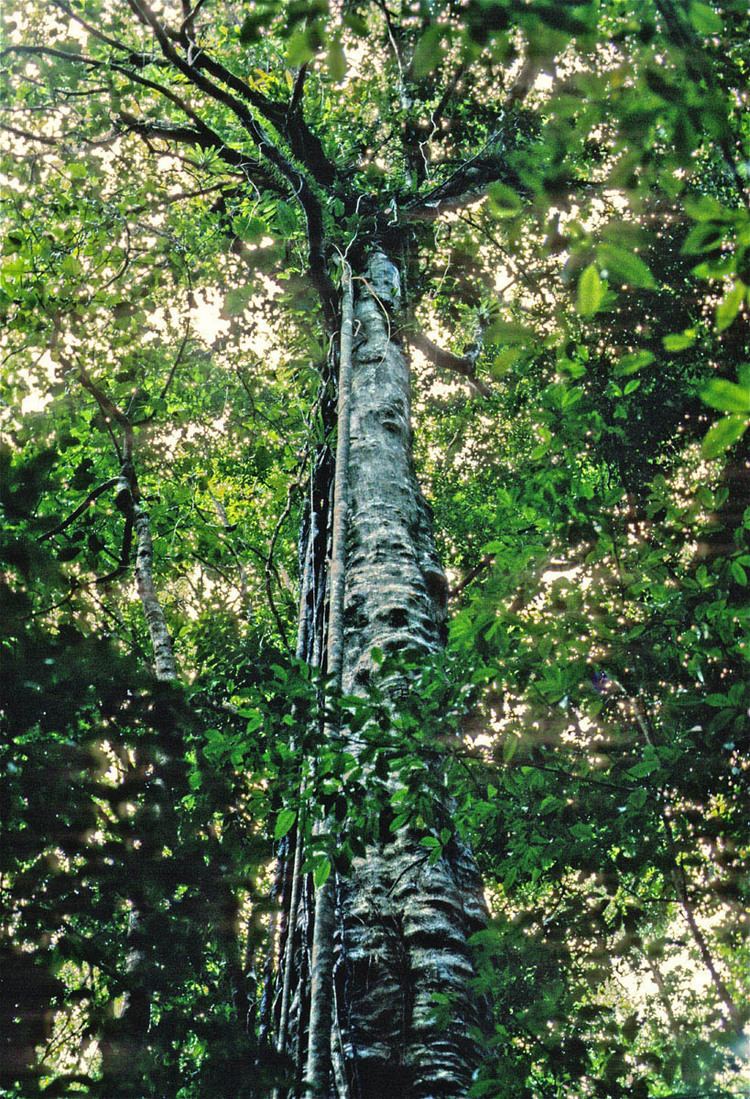Rank Species | Genus Dacryodes Higher classification Dacryodes | |
 | ||
Similar Dacryodes, Prestoea montana, Cecropia schreberiana, Prestoea, Magnolia splendens | ||
Le gommier blanc dacryodes excelsa
Dacryodes excelsa is a tree native to Puerto Rico with a habitat that extends into the Lesser Antilles in the Caribbean region. Its English vernacular names include gommier and candlewood. Its Spanish common name is tabonuco. It is found in Toro Negro State Forest, in the Puerto Rico Cordillera Central.
Contents
- Le gommier blanc dacryodes excelsa
- Habitat
- Life Cycle
- Uses Of Dacryodes Excelsa
- Historical Significance
- References
Habitat

Dacryodes excelsa, commonly referred to as Tabonuco, is found only in South and Central America, with a native elevation of 200 to 900 meters. Its range extends from Puerto Rico to the Caribbean islands, growing as far south as the islands of St. Vincent and Grenada.
The tabonuco tree primarily grows in protected forest sites at low elevations and comprises one of the four main rainforest types in Puerto Rico. Tabonuco trees can make up to 35% of the upper forest canopy in the lower elevations of the Puerto Rican rainforest.

Dacryodes excelsa prefers temperatures that range between 21° to 25° C (70° to 77° F), and a mean relative humidity of 91%. These trees usually grow in deep red clay soil with a slightly acidic profile between pH 4.5 and 5.5.
Large tabonuco trees are more common on upper slopes and ridges, where they can form nearly pure groups with grafted roots, forming a tree union or clumps of trees. This gives the roots better drainage and allows the trees to use large boulders and cliffs as a shield against the hurricane winds common in Puerto Rico.
Life Cycle

Dacryodes excelsa is a dioecious species, meaning that the male and female blooms grow on different trees. Flowering season peaks between May to November, with most tabonuco fruits falling between October to December.
Both empty and fertile fruits are produced during flowering, and empty fruits commonly drop earlier than fertile ones. The small fruits have only one seed and have an oblong-ovoid shape. The seeds themselves are fleshy, with folded cotyledons.
In nature, steep slopes with low light intensities are the finest places for seedlings to thrive. Seedlings typically do not survive exposure to direct sunlight in their first month. At around four months, tabonuco seedlings grow to an average of 6 inches (16 cm) and only half of the viable seedlings will grow past eight months.
Upon reaching nine years, tabonuco trees were recorded to be between 10 to 14 feet (3 to 4.3 meters) tall and continuously grow and reproduce throughout their lifespan. Only a tiny percentage of fallen tabonuco seeds mature to adulthood due to the harsh competition in the Puerto Rican rainforest.

Tabonuco trees prefer to take root in higher slopes and ridges, allowing them to consistently survive hurricane winds that break tree crowns rather than uprooting them. This suggests that the tabonuco has a robust and possibly intertwined root system when clumped together in a tree union.
Mature tabonuco trees are forest giants, reaching up to 100 feet (30 meters) tall, with a diameter of 40 inches (1 meter). The largest tabonuco trees are estimated to be 400 years old.
Uses Of Dacryodes Excelsa

Tabonuco wood is well-suited for carpentry, cabinet work, furniture, general construction, crates, boxes, roofing, and small boats or canoes. The wood itself has a reddish-yellow color and is decently hard, making it a good substitute for mahogany or birch wood.
Tabonuco lumber air-seasons effortlessly and adequately and undergoes mild but uniform shrinkage during seasoning. Tabonuco wood is decent wood for machining, since it’s cut and sawed easily, though its high silica content tends to dull saw blades quickly.
It is easy to glue, retains nails securely, resistant to staining, and is beautifully finished with varnish or lacquer. The wood is also slightly resistant to decay, and is able to last up to three years in the ground.
The white resin produced by tabonuco bark has a pleasant aroma and is flammable, making it perfect for making candles, torches, and incense.
Tabonuco fruits are also a food source for many of Puerto Rico’s endemic fauna. The famously endangered Puerto Rican parrot commonly feeds on tabonuco fruits. The small size of the seeds allows them to travel through animals’ digestive systems, being excreted with their droppings.
Historical Significance

Before Spanish colonization, the tabonuco tree was used as the main lumber tree of early native Puerto Ricans. Its reddish-yellow wood was used by the native Puerto Ricans to make furniture, boxes for storage, and wooden tools and implements.
The smooth, pale bark of the tabonuco tree produces a flammable white resin, which was used by native Puerto Ricans in rituals and as medicine. This white resin was routinely used as incense, as the natives believed that its pleasant aroma pleased the gods. The natives once thought that the tabonuco tree’s white sap appeared only during full moons, but later learned to tap the tree to harvest the valuable resin at will.
The Taino people of the Caribbean carved dugout canoes from the trunks of huge tabonuco trees, giving the Tainos the ability to traverse short to medium distances at sea. The Tainos also used its lumber to make crates, furniture, oars, and other implements.

Spanish settlers in Puerto Rico learned about the tabonuco tree from the natives and were taught how to harvest the white resin. Tabonuco resin was used by early settlers to make candles and torches, to caulk boats, to make incense, and for medicinal purposes. Green branches were also used as long-lasting natural torches due to their high resin content.
